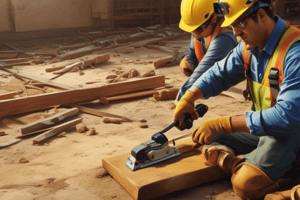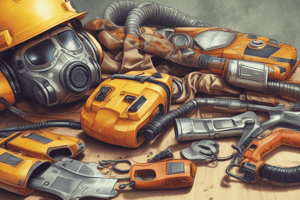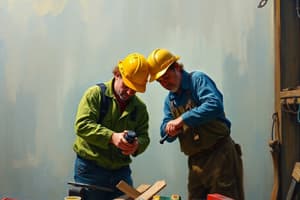Podcast
Questions and Answers
What is a key aspect to consider when selecting tools for a task?
What is a key aspect to consider when selecting tools for a task?
- Tool weight
- Tool adaptability
- Manufacturer reputation (correct)
- Tool color
Why is calibrating tools and measuring instruments important?
Why is calibrating tools and measuring instruments important?
- To waste time
- To ensure accurate results (correct)
- To avoid record keeping
- To increase errors
What factor should be considered in precision measurement to minimize human error?
What factor should be considered in precision measurement to minimize human error?
- Tool quality (correct)
- Tool color
- Temperature and humidity
- Calibration frequency
Which technique is recommended for achieving precision in measurements?
Which technique is recommended for achieving precision in measurements?
Why is record keeping important in the calibration process?
Why is record keeping important in the calibration process?
What should be avoided to ensure objective measurements?
What should be avoided to ensure objective measurements?
What is a crucial aspect of using equipment to protect both the operator and the work environment?
What is a crucial aspect of using equipment to protect both the operator and the work environment?
Why is it important to keep tools in good working order according to the text?
Why is it important to keep tools in good working order according to the text?
What is a key consideration when selecting a tool for a task?
What is a key consideration when selecting a tool for a task?
Why is tool durability an important factor when choosing tools?
Why is tool durability an important factor when choosing tools?
Chisels are used for marking or making an indentation in metal.
Chisels are used for marking or making an indentation in metal.
Vise is a holding tool used to mark parts during cutting and drilling operations.
Vise is a holding tool used to mark parts during cutting and drilling operations.
Wire brushes are primarily used for removing heavy rust on parts.
Wire brushes are primarily used for removing heavy rust on parts.
Drills are the most common tool for general automotive work.
Drills are the most common tool for general automotive work.
Drill press is only powered electrically for general automotive work.
Drill press is only powered electrically for general automotive work.
Flashcards are hidden until you start studying
Study Notes
Mastering Tools, Equipment, and Measurement: Unlocking Safety, Selection, and Precision
Whether you're a DIY enthusiast or a professional in an industry that relies on tools and measurements, understanding the fundamentals of tool safety, selection, and calibration techniques helps ensure accurate, efficient, and—most importantly—safe outcomes.
Tool Safety: Foundation for Success and Protection
Tool safety is a crucial aspect of using equipment, protecting both you and your work environment. Following these core principles will reduce injuries and accidents:
- Proper training: Ensure that operators are adequately trained in the use of equipment.
- Safety gear: Use appropriate personal protective equipment (PPE), such as safety glasses, gloves, and hearing protection.
- Proper maintenance: Keep tools in good working order to prevent malfunctions and injury.
- Tool identification: Clearly label tools and equipment with their intended use and hazard warnings.
- Tool storage: Store tools in appropriate cabinets, toolboxes, or on walls to prevent damage and reduce trip hazards.
Tool Selection: Choosing the Right Instrument for the Job
Selecting the right tool for the job is essential for achieving the best results. Here are some considerations when choosing a tool:
- Tool purpose: Ensure the tool meets the specific requirements of the task at hand.
- Tool durability: Select tools with a reputation for robustness and longevity.
- Tool efficiency: Choose tools that work efficiently and reduce time spent on a task.
- Manufacturer reputation: Opt for well-established, reputable manufacturers with a track record of producing quality tools.
- Tool adaptability: Consider tools that are versatile and can be used in multiple applications.
Calibration Techniques: Ensuring Precision and Accuracy
Calibrating tools and measuring instruments is essential for ensuring accurate results. Calibration techniques include:
- Frequency: Establish a regular calibration schedule to ensure accuracy.
- Calibration standards: Use reputable calibration standards to ensure the highest level of accuracy.
- Calibration method: Use a calibration method suitable for the equipment and the application.
- Traceability: Ensure the calibration process maintains traceability to a recognized national standard.
- Record keeping: Maintain accurate records of calibration results and due dates for future reference.
Precision Measurement: Achieving Accuracy in Everything You Do
Precision measurement is a vital part of any industry that relies on accurate measurements. Here are some tips for achieving precision in measurements:
- Tool quality: Ensure that the tools and equipment used for measurement are of the highest quality.
- Measurement techniques: Use techniques that minimize the impact of human error and provide the most accurate results.
- Environmental factors: Consider environmental factors, such as temperature and humidity, which can affect the accuracy of measurements.
- Avoiding bias: Be aware of potential sources of bias and ensure that measurements are as objective as possible.
- Standardize procedures: Establish standardized procedures for making measurements to ensure consistency and accuracy.
As you've seen, mastering tools, equipment, and measurement techniques is a multifaceted process that requires a combination of safety knowledge, tool proficiency, and precision-driven calibration techniques. By understanding these core principles, you'll be well on your way to achieving success in your projects and maintaining a safe working environment.
Studying That Suits You
Use AI to generate personalized quizzes and flashcards to suit your learning preferences.





